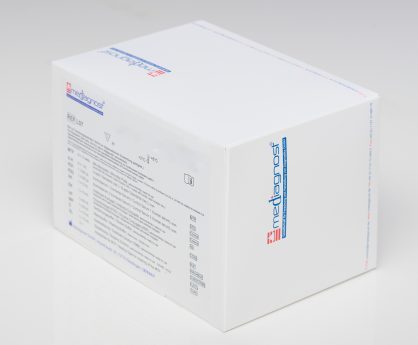IGF-1 ELISA Assay Kit
The IGF-1 ELISA Assay Kit is For Research Use Only
Size: 1×96 wells
Sensitivity: 0.11 ng/mL
Dynamic Range: 2 – 50 ng/ml
Incubation Time: 1.75 hours
Sample Type: Serum, Plasma
Sample Size: 10 µL
Conversion Factor
ng/mL = nmol/L x 0.13
nmol/L = ng/mL x 7.65
Product is manufactured by Mediagnost
Assay Principle
In order to dissociate IGF-I from the IGFBPs, the samples must be diluted in an acidic buffer (Sample Buffer PP). The diluted samples are then pipetted into the assay wells. The IGF-I antiserum is dissolved in a buffer, which is able to neutralize the acidic samples. After the IGF-I antibody solution has neutralized the samples, the present excess IGF-II occupies the IGF-binding sites of the binding proteins, thus allowing the measurement of the resulting free IGF-I. With this method, the IGFBPs are not removed, but their function and therefore their interference in the assay is neutralized. Due to the extremely low cross-reactivity of the IGF-I antibody with IGF-II, the excess of IGF-II does not disturb the interaction of the first antibody with IGF-I.
The Eagle Biosciences ELISA for IGF-I is a so-called Sandwich-Assay using two specific and high-affinity antibodies. The IGF-I in the samples binds to the first antibody coated on the microtiterplate, the second specific anti-IGF-I-antibody binds in turn to the immobilised IGF-I. The second antibody is biotinylated, the subsequently incubated Streptavidin-Peroxidase-Enzyme Conjugate will bind to it, and thus in the final substrate incubation step colour development will be catalysed quantitatively depending on the IGF-I-level of the samples. The Standards of this ELISA are prepared from recombinant IGF-I in concentrations of 2, 5, 15, 30 and 50 ng/ml.
The standards are derived from recombinant hIGF-I devoid of methIGF-I or IGF-I variants with mismatched disulfide bonds, i.e. this recombinant IGF-I is identical to the major authentic IGF-I form in blood. The Eagle Biosciences, Inc. IGF-I enzymeimmunoassay is calibrated against the International Reference Standard preparation of IGF-I, WHO NIBSC Code 02/254.
Related Products
IGF-II ELISA Assay Kit
Human IGFBP-1 ELISA Assay
IGFBP-2 ELISA Assay Kit


